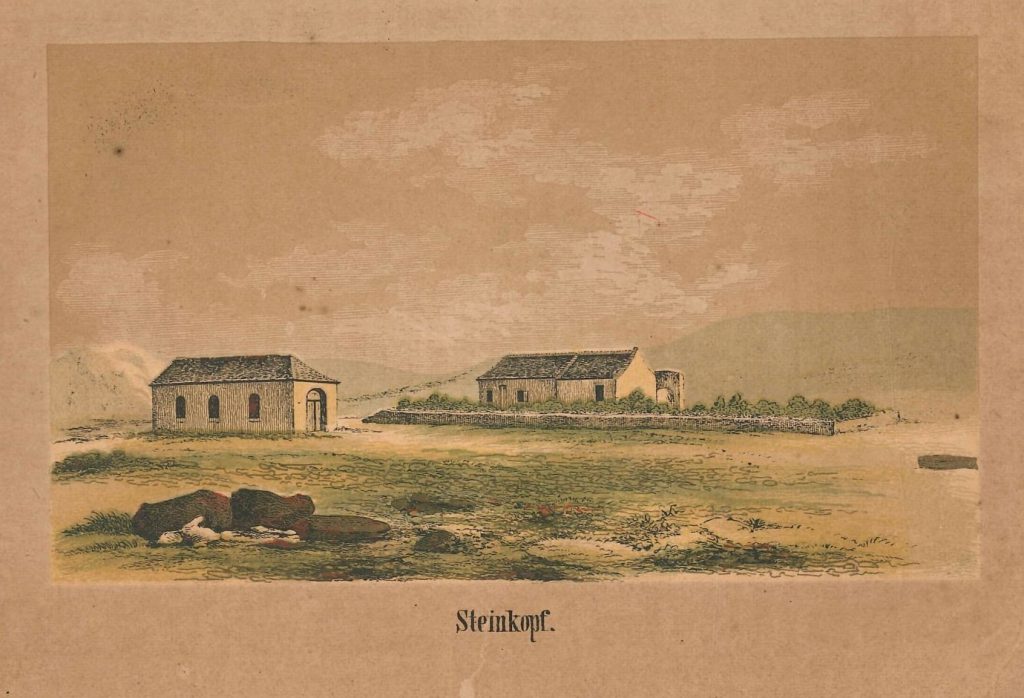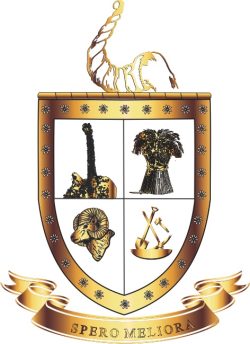Mission Station of Rhenish Missionary Society

In 1840 the London Missionary Society transferred its work in Namaqualand to the Rhenish Mission Society, a German organisation. For the first few years no missionary was stationed at Steinkopf and the mission station was served by visiting missionaries from Komaggas. In 1846 the Rev. Ferdinand Brecher, who was to stay at Steinkopf for about fifty years, start to work as missionary in the community.
Elfrede Strassberger reported on the work of the Rev. Brecher:
“Brecher found sixty people who had been at Kookfontein, where the old Captain Abraham (Vigiland Orlam was called Abraham after his baptism as Christian) and his wife (Sarah) received him with great joy. The number of baptised persons soon increased to 300. The congregation was scattered over 1600 square miles. They were constantly moving. Brecher endeavoured to persuade them to live a settled life. He encouraged agriculture and the cultivation of grain and other crops. He built a church, a school and a mission house. At Christmas time he assembled the congregation to celebrate the festivities. After the celebrations they once more dispersed in all directions.
This made his work very difficult.”
Rev. Brecher’s term as missionary also saw some important changes Steinkopf. The first of these was the extension of the boundary the Cape Colony to the Orange River in 1847 and Steinkopf was now under colonial rule and the people became British subjects. Around 1850 commercial mining of copper also started in Namaqualand which had a huge impact on the mission station at Steinkopf. Local residents benefitted from income of work on the mines and the transporting of copper. In 1873 the copper railway line was completed to Steinkopf and the town had its own railway station. More cash was available and new developments came to the community. Some people started to build better houses, the income of the mission increase and congregation became more self-supporting. The work at the mines also led to neglect of the farming, increase substance abuse and an increase of dependence of local shops. A mine was also open on the farm Tweefontein, which was part of Steinkopf Mission Station which led to the development of a mining town called Concordia.
The wars during the turn of the 19th to 20th century also did not leave Steinkopf untouched. Steinkopf became part of the Anglo-Boer War when a large force of Boers invaded Namaqualand in 1901. Martial Law was proclaimed throughout the district. About 100 men form the community joined the English military forces as volunteers. They were part of the Town Guards and Namaqualand Border Scouts. Steinkopf was invaded by the Boers in April 1902 and local people fled by train to Port Nolloth where they stayed in refugee camps. The siege of Steinkopf ended on the 1st of May 1902 when the Boers left the town after heavy fighting against the British relief forces.
The money economy in Steinkopf started in 1887, when first trading licenses were issued by the Community Council. They were issued to German traders including the Brecher family. After 1900 several Jewish businesspeople also settled in Steinkopf, like elsewhere in Namaqualand. Several of them wer shop owners will some of them also became involved in prospecting and mining. These Jews left Steinkopf after the introduction of apartheid when Steinkopf was declared a Coloured Rural Area and they were forced to leave.
A second war that impact on the community of Steinkopf was the battles between the German colonial forces and the indigenous Nama and Herero’s from 1903 to 1906 in neighbouring Namibia, then called German Southwest Africa. Military resources were imported through the railway line and transported from Steinkopf across the Orange River. Local people benefitted from the transport riding of these goods to Namibia. After the war more then 600 people crossed the Orange River as refugees and stayed for a few months outside Steinkopf. Because the local authorities at Steinkopf did not want to give them shelter they were placed in a refugee camp at the Roman Catholic Mission Station at Matjieskloof. The local councillors, who was Basters, did not want to allow such a large group of Nama in Steinkopf because they were afraid that they would lose political control in the community.
In 1910 the Union of South Africa was formed when the colonies of Natal and the Cape, joined forces with the two Boer republics, Transvaal and Orange Free State, to form a white dominated South African state. This was one of the major forms of betrayal of the British against their previous allies when they joined forces with their former enemies during the Anglo-Boer War. In Steinkopf the impact of this unholy alliance was the introduction of the 1909 Mission Stations and Communal Reserve Act which brought direct government control over the community. The old Community Council was desolved and the church lost its control over community affairs. A Board of Control consisting of local councillors and chaired by the magistrate from Springbok replaced it.
During the 1st World War, 1914 – 1919, many troops and supplies through Steinkopf during the earlier phase of the War when German Southwest Africa was invaded. Many local also participated in the war as soldiers both in South Africa and abroad. The local missionary, the Rev. Kling, was interned and send to Pietermaritzburg during this war because he was a German citizen.
When diamond mining started in the 1920’s on the west coast of Namaqualand at places like Kleinzee and Alexander Bay, people from Steinkopf went to the mines as migrant workers. This was an economic relationship between Steinkopf and the diamond mines which lasted for most of the 20th and into the 21st century.
The Rhenish Mission Society ended their work in Steinkopf in 1934 because of financial challenges and transfer the mission work to the Dutch Reformed Church. This brought an end to about 94 years of service to the community and of German influence in Steinkopf.
